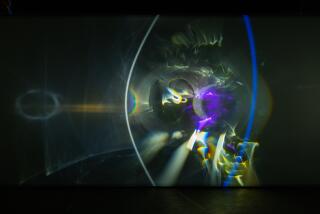O.C. ART / WILLIAM WILSON : Going Where Those Wile Things Are : An exhibit of Tony Delap’s work at Cal State Fullerton suggests that the most fascinating thing about magic is our reaction to it.
- Share via
Tony Delap’s art took wing in the ‘60s among that flock that distilled the youth cults of the hot-rod and the surfboard into the Southland Slick School. The whole enterprise played to the accompaniment of waves of pop music. The pertinent ditty for Delap certainly was the Lovin’ Spoonful’s “Do You Believe in Magic?”
Now, three decades later, all that is a history to be sorted and mulled, and Cal State Fullerton’s gallery director Mike McGee is offering contemplation of Delap’s work in an installation blending re-created works and graphics that span the decades, making something of a vest-pocket retrospective.
There’s a handsome catalogue designed by Jerry Samuelson that contains ponderable essays by Peter Clothier and David Pagel. The whole flies under the title “The House of the Magician,” as Delap’s art is about our continuing belief in certain illusions even after we know how they work.
The most uncharacteristic but visually delightful piece on view is “Floating Lady.” The role is played in rotation by a series of female student volunteers. At first glance the piece seems to present an approximation of the old stage magician’s levitation trick. The girl hovers in the air, suspended above a folding chair.
Mind you, it’s perfectly obvious that she is resting on a horizontal support, a kind of shelf contraption. Yet one wonders how the shelf is held firm by the flimsy chair, and how it supports the weight of the young woman. But the ultimate fascination takes place in the viewer’s mind. Rather than denounce the piece to ourselves as a cheap trick, we prefer to maintain it as a wonderful thing.
“Floating Lady” firmly brings to mind the Cool School’s old master guru, Marcel Duchamp. Duchamp made us see all manner of objects as artworks by waving the magic wand of the artist’s wit, will and irony. He planted the notion that art is a patent illusion that works because artist and viewer alike wish to suspend disbelief.
Literal suspension dominates much of Delap’s work. “Large Blue Beam” greets viewers at the door. It hovers nose-high, seeming to emerge at an angle from the far wall passing through a glass pane. “Floating Lady III” is a wood beam across the gallery space. Ordinary enough, except a gap in the middle seems to make it defy gravity. Oh. A piece of plexiglass spans the gap. That explains it. But not quite.
“Houdin’s House” is named for a French magician who inspired Harry Houdini. It’s a three-sided metal enclosure with two panes of glass angled from the center to the open corners. The glass reflects surroundings, but the mirrored images seem to be on the metal walls where they don’t belong. Delap’s deadpan delivery makes the illusion delightful. Earnest historians will note that the work makes a bridge between the Finish Fetish a la Billy Al Bengston and Larry Bell’s version of Light and Space art.
Delap’s graphic series is more relaxed fun than his minimalist sculpture. He shows a Parisian Ferris wheel with only one spoke, an ace disappearing into a prestidigitator’s palm, and a stick that levitates from a thumb. It doesn’t minimize the wizardry at all that these effects are simple cut-and-paste graphic design devices.
Delap’s greatest achievement may be in providing an open sesame to the Southland aesthetic. To this day, his colleagues from Ken Price to Ed Moses and Bob Graham strive to “make it magic.”
Delap’s fans also will want to see his work at Santa Monica’s Mark Moore Gallery, through Saturday.
* “The House of the Magician” continues through March 13 (except Saturdays) in the Main Art Gallery in the Visual Arts Center at Cal State Fullerton, 800 N. State College Blvd., Fullerton. (714) 773-3262. The Mark Moore Gallery is 2032A Broadway in Santa Monica. (310) 453-3031.
More to Read
The biggest entertainment stories
Get our big stories about Hollywood, film, television, music, arts, culture and more right in your inbox as soon as they publish.
You may occasionally receive promotional content from the Los Angeles Times.










